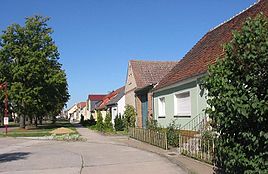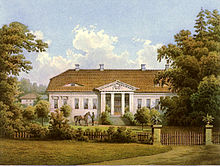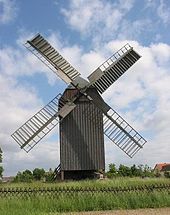Cammer (broken tarpaulin)
|
Cammer
Community Planebruch
Coordinates: 52 ° 15 ′ 30 ″ N , 12 ° 39 ′ 41 ″ E
|
|
|---|---|
| Height : | 43 m above sea level NHN |
| Area : | 9.55 km² |
| Residents : | 444 (2016) |
| Population density : | 47 inhabitants / km² |
| Incorporation : | January 31, 2002 |
| Postal code : | 14822 |
| Area code : | 033835 |
Cammer is a municipality Planebruch in office bridge , Potsdam-Mittelmark ( Brandenburg ).
geography
Cammer is located on the border of the Glogau-Baruther glacial valley - which also includes the Belziger landscape meadows - and the Zauche ridge . The Fläming is within sight . The center of the village is about 43 m above sea level. There are hardly any differences in altitude within the village center. A few examples can illustrate this:
- at the Rosenmüller Mühle: 44.56 m above sea level NN (sea level)
- at the school: 43.28m above sea level NN
- at the corner of Kietzstrasse: 42.26m above sea level NN
- Kietzstraße 13: 42.25m above sea level NN
The total usable area of Cammer is 954.6 hectares. This is divided into 522.68 hectares of arable land, 423 hectares of meadows and around 9 hectares of garden land. The former manor Cammer had a total area of 1200 hectares, including Oberjünne , which is now part of the municipality of Planebruch. The river Plane forms the southern border of the village . According to the surveying office of the Potsdam-Mittelmark district, the geographical center of the district is at the Forsthaus Tornow , which is in the Cammer district.
history
The first documentary mention of Cammer is probably the mention of a brewer named Katharina de Camere in the “Schöppenbuch der Stadt Treuenbrietzen”, who bequeathed all goods to her daughter of the same name when she died in 1333. The personal name de Camere is very likely a name of origin. It can be assumed that it is this Cammer. Reinhard E. Fischer adopts a transferred place name, most likely from Ter Kameren, La Cambre , a Cistercian convent in the municipality of Ixelles / Elsene in the Brussels Capital Region ( Belgium ). Ter Kameren was first mentioned in a document in 1208. A possible intermediate station of the transmission was perhaps Kamern in the district of Stendal (first mentioned: 1354). The etymology of the starting point Ter Kameren belongs to the Central Dutch "Kamer f.", Which, among other things, had the meaning "hut, small house". The feminine gender of the name matches that of the Dutch place of origin. If this explanation is correct, Cammer should actually speak of “the Cammer” in the female form.
prehistory
However, there was certainly a settlement here over 2,000 years ago. Time and again urn grave fields have been found around Cammer. Both the farmers and the forest workers found individual urns, objects such as flints and implements made from bones. In 1926, 1961, 1965 and 1966 there were extensive excavations at and in Cammer. The cemetery was used for the period between 100 years BC. And dated 150 years AD.
Ownership history
The village was probably created around 1200 in the course of the state development of the Zauche. In 1375 the manor Cammer belonged to the Wichard von Rochow auf Golzow . In 1578 the manor Cammer came to the von Arnim family . In 1579 a knight seat in Cammer is mentioned. This was located at the former castle site. In 1609 the Lords of Broesigke bought the knight's seat, which they owned until 1945. Albert von Broesigke (1797–1867) built the stately new building there in 1829 after the old manor house with all its farm buildings had been destroyed in a fire. The mansion was demolished from 1949 to 1950. The park still covers 12 hectares and has an extensive population of old trees with numerous ponds and islands. The forest and garden shed, the ice cellar and the horse stable as well as the burial mound where Heino von Broesigke was buried in 1996 as the last of his family have been preserved.
Until 1815 Cammer was a border town. The border between Saxony and Brandenburg ran along the tarpaulin. Three landmarked border stones still remind of this.
politics
The mayor of Cammer is Ulf Dingelstaedt, who is also the honorary mayor of the municipality of Planebruch. There is no local advisory board.
Population development
- 1812: 430 inhabitants
- 1835: 535 inhabitants
- 1859: 789 inhabitants
- 1925: 835 inhabitants
- 1945: 1,200 inhabitants (many refugees)
- 1983: 575 inhabitants
- Present: 451 inhabitants
Attractions
Post mill
Comprehensively restored post mill with louvre blades and grinding technology such as shotgun, motorized grinding system with roller frame and throw sifter, squeezer. The mill is windy. Windmill location since 1700 under the lordship of Cammer. Around 1830 the mill is bought by the miller Zschinsky. In 1878 it went to Carl Spiesecke from Ragösen. His family ran a mill, bakery and small farm. In 1894 the mill was overturned by a storm. In the same year, the present mill from the area around the Holy See in Potsdam is purchased and relocated. 1934 Installation of two electric motors, a roller mill and elevators. From 1939 the mill is only operated with electrical energy. 1951 shutdown of the mill and slow decay. Reconstruction from 1984. Several restorations after decay, the last one until 2008.
Rosenmüller's Dutch mill
Small commercial mill in a former tower windmill from 1833 with an extension from around 1890, 6 t refill mill, 2 roller mills (500 and 600 series), pneumatics, 4-part plansifter, a 600 roller mill for grinding and squeezing, cleaning: Happler, President, peeling and brushing machine, net screw, round grain belt, squeezer, hexagonal double chairs, plansifter, cleaning, drive via electric motor. Use as a commercial mill, production of rye baked meal, sale of animal feed. Activities: Mill tour on request, especially for school classes and kindergarten groups.
Village church
The village church Cammer is essentially a medieval hall building , which was extended to the east in 1775. An apse was added at the end of the 19th century . The nave has a length of approx. 22 m and a width of 8.60 m. The eaves height of the ship is approx. 5.5 m, the roof pitch approx. 40 °. The tower with a floor plan of approx. 6 x 5.40 m is approx. 22 m high to the top of its hipped roof. The brick outer walls are founded on a field stone foundation. Renovation of the roof, the tower and the outer shell completed in 2014, so that the facade is now covered with ocher-colored clay plaster.
Landmarks
Three border stones from 1582 remind of the Saxon-Brandenburg border that ran south of Cammer until the Congress of Vienna in 1814/1815.
Manor park
Around 1800 the castle park in Cammer was laid out according to the Wörlitz model. It covers a total area of 12 hectares, that is 48 acres. There are peacocks and pheasant aviaries in the manor park. There is also a bird house with cockatiels and cockatiels. On the ponds there are mandarin ducks and black swans. Picturesque canals, wooden bridges and enchanted paths invite you to take a walk. The castle itself was demolished in 1949. The members of the estate, the von Brösigke family, were buried on a burial mound. Heino von Brösigke was buried here in 1996 as the last male member of the line. In the park and in the village, some boards set up by the village and local history association explain the history of the palace and park.
Leisure and events
Club life
There is a lively club life in Cammer. The oldest association is the "Mixed Choir Cammer", which was founded in 1886. The club also includes the chamber dancers, which were founded in 2008. A dance ensemble that is now known throughout the district and has already performed at the IGW.
The village and homeland association Cammer is the youngest; it was founded in 2009 after the 675th anniversary celebrations. The fishing club has existed since 1961, the AWO local group was founded in 1993.
The fire brigade association has been supporting the comrades of the volunteer fire brigade, who are also in the village, since 2006. It has an operations department that belongs to the Golzow fire brigade, a youth department and an honorary department.
Regular events
- Children's and Mill Festival on the German Mill Day (Whit Monday)
- Classic car meeting in the Gutspark, 2nd Sunday in July
- Glow Worm Night, on the last weekend in June, guided walk through the manor park around the glow worm
- Participation in the day of the open monument (2nd Sunday in September) and on the action day "Fire and Flame for our museums" (last Saturday in October) at the post mill
Living traditions
- Gentlemen, for ten days before Christmas, confirmands help the Christ Child on earth by walking through the village and announcing the festival with shawm sounds, on New Year's Eve there is another tour with New Year's wishes and collecting gifts. In 2019, an interest group submitted the application to put the man on the list of intangible cultural heritage of UNESCO.
- Easter fire on Holy Saturday
- Maypole erection on May 1st
- Whitsun May, at Whitsun, the house entrances are decorated with birch branches
- Children's and mill festival on the German Mill Day on Whit Monday
- Unity fire, a fire is lit the day before Unity Day (October 3rd)
literature
- Georg Dehio (arr. Gerhard Vinken and others): Handbook of German art monuments . Brandenburg. Deutscher Kunstverlag Munich Berlin, 2000, ISBN 3-422-03054-9 .
- Reinhard E. Fischer : Brandenburg name book. Part 1: Zauche. Böhlau, Weimar 1967.
- Horst Geissler in the "Publications of the Museum for Pre- and Early History Potsdam" 1971.
- Horst Geissler: "Excavations and Finds" 1963 and 1967.
- Karl-Heinrich Marschalleck : The Latène burial ground near Cammer (Zauch-Belzig district). Prehistoric Journal, 18, 1927, pp. 212–249.
- Karl-Heinrich Marschalleck: In the "home calendar for the district of Zauch-Belzig"
- Peter P. Rohrlach: Historical local dictionary for Brandenburg. Part V Zauch-Belzig. Hermann Böhlaus successor, Weimar 1967
- Andreas Koska, Cammer-2000 years of settlement history, Cammer 2019, ISBN 978-3-9820869-2-7
- ibid., Down the Himmelsleiter - Die Cammerschen Herrentuter, Cammer 2019, ISBN 978-3-9820869-3-4
- ibid. The Cammer Cookbook, Recipes for the Family, Cammer 2019, ISBN 978-3-9820869-1-0
- ibid., from Cammer, in Cammer -Cammeraner or Cammersche, portraits of people from a Zauche village, ISBN 978-3-9820869-0-3
Individual evidence
- ↑ Manor Park Cammer. Gartenland Brandenburg, archived from the original on February 22, 2014 ; accessed on March 17, 2017 .
- ↑ Cammer Milling
- ↑ a b All mills in Berlin and Brandenburg (PDF)



